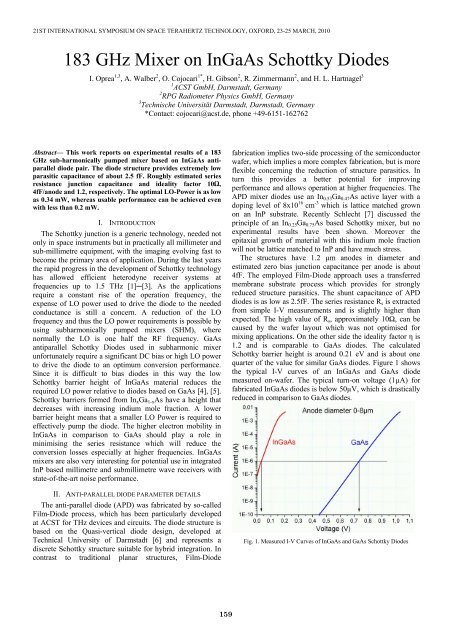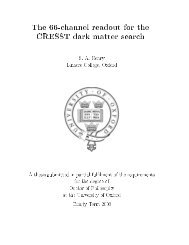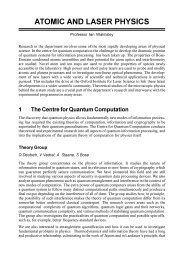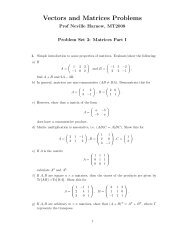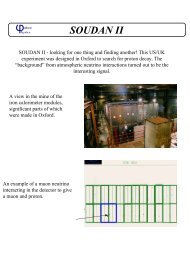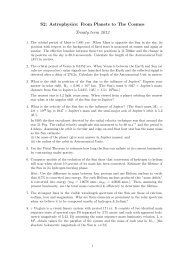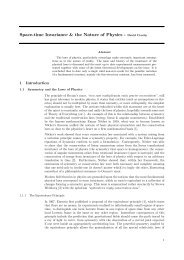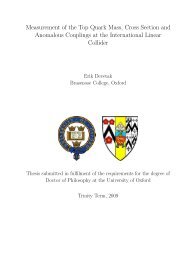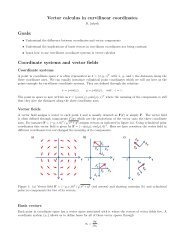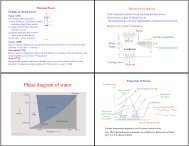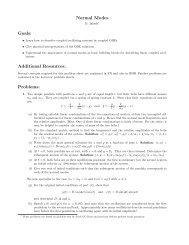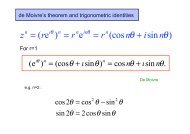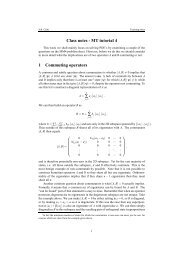Session S6: Schottky Diodes and Mixers - Department of Physics
Session S6: Schottky Diodes and Mixers - Department of Physics
Session S6: Schottky Diodes and Mixers - Department of Physics
Create successful ePaper yourself
Turn your PDF publications into a flip-book with our unique Google optimized e-Paper software.
21ST INTERNATIONAL SYMPOSIUM ON SPACE TERAHERTZ TECHNOLOGY, OXFORD, 23-25 MARCH, 2010<br />
183 GHz Mixer on InGaAs <strong>Schottky</strong> <strong>Diodes</strong><br />
I. Oprea 1,3 , A. Walber 2 , O. Cojocari 1* , H. Gibson 2 , R. Zimmermann 2 , <strong>and</strong> H. L. Hartnagel 3<br />
1 ACST GmbH, Darmstadt, Germany<br />
2 RPG Radiometer <strong>Physics</strong> GmbH, Germany<br />
3 Technische Universität Darmstadt, Darmstadt, Germany<br />
*Contact: cojocari@acst.de, phone +49-6151-162762<br />
Abstract This work reports on experimental results <strong>of</strong> a 183<br />
GHz sub-harmonically pumped mixer based on InGaAs antiparallel<br />
diode pair. The diode structure provides extremely low<br />
parasitic capacitance <strong>of</strong> about 2.5 fF. Roughly estimated series<br />
resistance junction capacitance <strong>and</strong> ideality factor 10,<br />
4fF/anode <strong>and</strong> 1.2, respectively. The optimal LO-Power is as low<br />
as 0.34 mW, whereas usable performance can be achieved even<br />
with less than 0.2 mW.<br />
I. INTRODUCTION<br />
The <strong>Schottky</strong> junction is a generic technology, needed not<br />
only in space instruments but in practically all millimeter <strong>and</strong><br />
sub-millimetre equipment, with the imaging evolving fast to<br />
become the primary area <strong>of</strong> application. During the last years<br />
the rapid progress in the development <strong>of</strong> <strong>Schottky</strong> technology<br />
has allowed efficient heterodyne receiver systems at<br />
frequencies up to 1.5 THz [1][3]. As the applications<br />
require a constant rise <strong>of</strong> the operation frequency, the<br />
expense <strong>of</strong> LO power used to drive the diode to the needed<br />
conductance is still a concern. A reduction <strong>of</strong> the LO<br />
frequency <strong>and</strong> thus the LO power requirements is possible by<br />
using subharmonically pumped mixers (SHM), where<br />
normally the LO is one half the RF frequency. GaAs<br />
antiparallel <strong>Schottky</strong> <strong>Diodes</strong> used in subharmonic mixer<br />
unfortunately require a significant DC bias or high LO power<br />
to drive the diode to an optimum conversion performance.<br />
Since it is difficult to bias diodes in this way the low<br />
<strong>Schottky</strong> barrier height <strong>of</strong> InGaAs material reduces the<br />
required LO power relative to diodes based on GaAs [4], [5].<br />
<strong>Schottky</strong> barriers formed from In x Ga 1-x As have a height that<br />
decreases with increasing indium mole fraction. A lower<br />
barrier height means that a smaller LO Power is required to<br />
effectively pump the diode. The higher electron mobility in<br />
InGaAs in comparison to GaAs should play a role in<br />
minimising the series resistance which will reduce the<br />
conversion losses especially at higher frequencies. InGaAs<br />
mixers are also very interesting for potential use in integrated<br />
InP based millimetre <strong>and</strong> submillimetre wave receivers with<br />
state-<strong>of</strong>-the-art noise performance.<br />
II. ANTI-PARALLEL DIODE PARAMETER DETAILS<br />
The anti-parallel diode (APD) was fabricated by so-called<br />
Film-Diode process, which has been particularly developed<br />
at ACST for THz devices <strong>and</strong> circuits. The diode structure is<br />
based on the Quasi-vertical diode design, developed at<br />
Technical University <strong>of</strong> Darmstadt [6] <strong>and</strong> represents a<br />
discrete <strong>Schottky</strong> structure suitable for hybrid integration. In<br />
contrast to traditional planar structures, Film-Diode<br />
fabrication implies two-side processing <strong>of</strong> the semiconductor<br />
wafer, which implies a more complex fabrication, but is more<br />
flexible concerning the reduction <strong>of</strong> structure parasitics. In<br />
turn this provides a better potential for improving<br />
performance <strong>and</strong> allows operation at higher frequencies. The<br />
APD mixer diodes use an In 0.53 Ga 0.47 As active layer with a<br />
doping level <strong>of</strong> 8x10 16 cm -3 which is lattice matched grown<br />
on an InP substrate. Recently Schlecht [7] discussed the<br />
principle <strong>of</strong> an In 0.25 Ga 0.75 As based <strong>Schottky</strong> mixer, but no<br />
experimental results have been shown. Moreover the<br />
epitaxial growth <strong>of</strong> material with this indium mole fraction<br />
will not be lattice matched to InP <strong>and</strong> have much stress.<br />
The structures have 1.2 µm anodes in diameter <strong>and</strong><br />
estimated zero bias junction capacitance per anode is about<br />
4fF. The employed Film-Diode approach uses a transferred<br />
membrane substrate process which provides for strongly<br />
reduced structure parasitics. The shunt capacitance <strong>of</strong> APD<br />
diodes is as low as 2.5fF. The series resistance R s is extracted<br />
from simple I-V measurements <strong>and</strong> is slightly higher than<br />
expected. The high value <strong>of</strong> R s , approximately 10, can be<br />
caused by the wafer layout which was not optimised for<br />
mixing applications. On the other side the ideality factor is<br />
1.2 <strong>and</strong> is comparable to GaAs diodes. The calculated<br />
<strong>Schottky</strong> barrier height is around 0.21 eV <strong>and</strong> is about one<br />
quarter <strong>of</strong> the value for similar GaAs diodes. Figure 1 shows<br />
the typical I-V curves <strong>of</strong> an InGaAs <strong>and</strong> GaAs diode<br />
measured on-wafer. The typical turn-on voltage (1µA) for<br />
fabricated InGaAs diodes is below 50µV, which is drastically<br />
reduced in comparison to GaAs diodes.<br />
Fig. 1. Measured I-V Curves <strong>of</strong> InGaAs <strong>and</strong> GaAs <strong>Schottky</strong> <strong>Diodes</strong><br />
159


